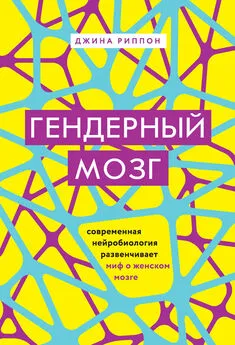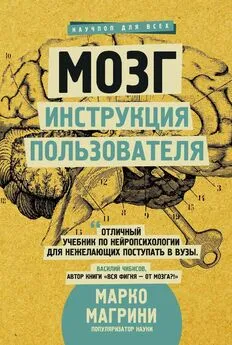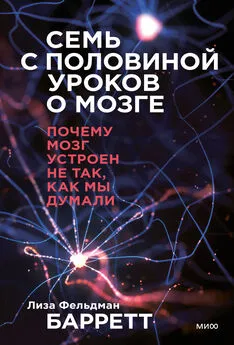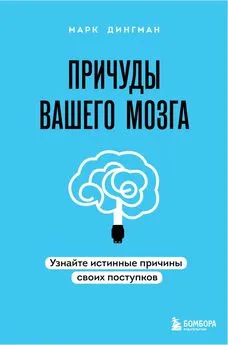Марк Дингман - Ваш мозг. Что нейронаука знает о мозге и его причудах
- Название:Ваш мозг. Что нейронаука знает о мозге и его причудах
- Автор:
- Жанр:
- Издательство:Эксмо
- Год:2020
- Город:Москва
- ISBN:978-5-04-115480-6
- Рейтинг:
- Избранное:Добавить в избранное
-
Отзывы:
-
Ваша оценка:
Марк Дингман - Ваш мозг. Что нейронаука знает о мозге и его причудах краткое содержание
Ваш мозг. Что нейронаука знает о мозге и его причудах - читать онлайн бесплатно ознакомительный отрывок
Интервал:
Закладка:
2.J.S. Johnson and E.L. Newport, “Critical Period Effects in Second Language Learning: The Influence of Maturational State on the Acquisition of English as a Second Language,” Cognitive Psychology 21, no. 1 (January 1989): 60–99.
3.J.K. Hartshorne, J.B. Tenenbaum, and S. Pinker, “A Critical Period for Second Language Acquisition: Evidence from 2/3 Million English Speakers,” Cognition 177 (August 2018): 263–277.
4.M. Brysbaert, M. Stevens, P. Mandera, and E. Keuleers, “How Many Words Do We Know? Practical Estimates of Vocabulary Size Dependent on Word Definition, the Degree of Language Input and the Participant’s Age,” Frontiers in Psychology 7 (July 2016): 1116.
5. P. Broca, “Remarks on the Seat of the Faculty of Articulated Language, Following an Observation of Aphemia (Loss of Speech)” trans. C.D. Green, Bulletin de la Societe Anatomique 6 (1861): 330–357.
6.K. Amunts, A. Schleicher, U. Burgel, H. Mohlberg, H.B. Uylings, and K. Zilles, “Broca’s Region Revisited: Cytoarchitecture and Intersubject Variability,” Journal of Comparative Neurology 412, no. 2 (1999): 319–341.
7.M.S. Gazzaniga and R.W. Sperry, “Language after Section of the Cerebral Commissures,” Brain 90, no. 1 (March 1967): 131–148.
8.T. Rasmussen and B. Milner, “Clinical and Surgical Studies of the Cerebral Speech Areas in Man,” in Cerebral localization, eds. K.J. Zulch, O. Creutzfeld, and G.C. Galbraith (New York: SpringerVerlag, 1975), 238–257.
9.A.K. Lindell, “In Your Right Mind: Right Hemisphere Contributions to Language Processing and Production,” Neuropsychol Review 16, no. 3 (September 2006): 131–148.
10.N. Geschwind, “The Organization of Language and the Brain,” Science 170, no. 3961 (November 1970): 940–944.
11.P. Tremblay and A.S. Dick, “Broca and Wernicke are Dead, or Moving Past the Classic Model of Language Neurobiology,” Brain and Language 162 (November 2016): 60–71.
12.A. Cooke, E.B. Zurif, C. DeVita, D. Alsop, P. Koenig, J. Detre, J. Gee, M. Pinango, J. Balogh, and M. Grossman, “Neural Basis for Sentence Comprehension: Grammatical and Short-Term Memory Components,” Human Brain Mapping 15, no. 2 (February 2002): 80–94.
13.N. Nishitani, M. Schurmann, K. Amunts, and R. Hari, “Broca’s Region: From Action to Language,” Physiology (Bethesda) 20 (February 2005): 60–69.
14.J.R. Binder, “The Wernicke Area: Modern Evidence and a Reinterpretation,” Neurology 85, no. 24 (December 2015): 2170–2175.
15.Tremblay and Dick, “Broca and Wernicke are Dead,” 60–71.
16.V. Fromkin, S. Krashen, S. Curtiss, D. Rigler, and M. Rigler, “The Development of Language in Genie: A Case of Language Acquisition Beyond the ‘Critical Period.’ ” Brain and Language 1 (1974): 81– 107.
17.M. Dapretto and E.L. Bjork, “The Development of Word Retrieval Abilities in the Second Year and Its Relation to Early Vocabulary Growth,” Child Development 71, no. 3 (May-June 2000): 635–648.
18.J.S. Johnson and E.L. Newport, “Critical Period Effects in Second Language Learning: The Influence of Maturational State on the Acquisition of English as a Second Language,” Cognitive Psychology 21, no. 1 (January 1989): 60–99.
19.Там же.
20. O. Adesope, T. Lavin, T. Thompson, and C. Ungerleider, “A Systematic Review and Meta-Analysis of the Cognitive Correlates of Bilingualism,” Review of Educational Research 80, no. 2 (2010): 207–245.
21E. Bialystok, F.L. Craik, and M. Freedman, “Bilingualism as a Protection against the Onset of Symptoms of Dementia,” Neuropsy-chologia 45 (2007): 459–464.
22.P.K. Kuhl, F.M. Tsao, and H.M. Liu, “Foreign-Language Experience in Infancy: Effects of Short-Term Exposure and Social Interaction on Phonetic Learning,” Proceedings of the National Academy of Sciences of the United States of America 100, no. 15 (July 2003): 9096–9101.
Глава 5
1.A. Dolan, “Always Smiling, the Stroke Patient Who Can’t Feel Sad,” The Daily Mail, August 12, 2013, Health, http://www.dailymail. co.uk/health/article-2389891/Always-smiling-stroke-patient-feel-sad-Condition-leaves-Grandfather-permanently-happy-prone-fits-giggles-inappropriate-times.html.
2.D.J. Felleman and D.C. Van Essen, “Distributed Hierarchical Processing in the Primate Cerebral Cortex,” Cerebral Cortex 1, no. 1 (1991): 1-47.
3.P. Broca, “Comparative Anatomy of the Cerebral Convolutions: The Great Limbic Lobe and the Limbic Fissure in the Mammalian Series,” Journal of Comparative Neurology 523, no. 17 (December 2015): 2501–2554.
4.J.W Papez, “A Proposed Mechanism of Emotion,” Archives of Neurology and Psychiatry 38 (1937): 725–743.
5.P.D. MacLean, “Some Psychiatric Implications of Physiological Studies on Frontotemporal Portion of Limbic System (Visceral Brain),” Electroencephalography and Clinical Neurophysiology 4, no. 4 (November 1952): 407–418.
6.M.S. George, T.A. Ketter, P.I. Parekh, B. Horwitz, P. Herscovitch, and R.M. Post, “Brain Activity during Transient Sadness and Happiness in Healthy Women,” American Journal of Psychiatry 152, no. 3 (March 1995): 341–351.
7.H.S. Mayberg, M. Liotti, S.K. Brannan, S. McGinnis, R.K. Mahurin, P.A. Jerabek, J.A. Silva, et al., “Reciprocal Limbic-Cortical Function and Negative Mood: Converging PET Findings in Depression and Normal Sadness,” American Journal of Psychiatry 156, no. 5 (May 1999): 675–682.
8.P.E. Greenberg, R.C. Kessler, H.G. Birnbaum, S.A. Leong, S.W. Lowe, P.A. Berglund, and P.K. Corey-Lisle, “The Economic Burden of Depression in the United States: How Did It Change between 1990 and 2000?” Journal of Clinical Psychiatry 64, no. 12 (December 2003): 1465–1475.
9.B. Voinov, WD. Richie, and R.K. Bailey, “Depression and Chronic Diseases: It Is Time for a Synergistic Mental Health and Primary Care Approach,” The Primary Care Companion for CNS Disorders 15, no. 2 (2013): PCC.12r01468.
10.A. Mykletun, O. Bjerkeset, S. Overland, M. Prince, M. Dewey, and R. Stewart, “Levels of Anxiety and Depression as Predictors of Mortality: The HUNT Study,” British Journal of Psychiatry 195, no. 2 (August 2009): 118–125.
11E.A. Osuch, T.A. Ketter, T.A. Kimbrell, M.S. George, B.E. Benson, M.W. Willis, P. Herscovitch, and R.M. Post, “Regional Cerebral Metabolism Associated with Anxiety Symptoms in Affective Disorder Patients,” Biological Psychiatry 48, no. 10 (November 2000): 1020–1023.
12.Mayberg et al., “Reciprocal Limbic-Cortical Function and Negative Mood,” 675–682.
13.T. Hajek, J. Kozeny, M. Kopecek, M. Alda, and C. Hoschl, “Reduced Subgenual Cingulate Volumes in Mood Disorders: A MetaAnalysis,” Journal of Psychiatry & Neuroscience 33, no. 2 (March 2008): 91–99.
14.D.L. Dunner, A.J. Rush, J.M. Russell, M. Burke, S. Woodard, P. Wingard, and J. Allen, “Prospective, Long-Term, Multicenter Study of the Naturalistic Outcomes of Patients with TreatmentResistant Depression,” Journal of Clinical Psychiatry 67 (2006): 688–695.
15.M.T. Berlim, A. McGirr, F. Van den Eynde, M.P. Fleck, and P. Giacobbe, “Effectiveness and Acceptability of Deep Brain Stimulation (DBS) of the Subgenual Cingulate Cortex for TreatmentResistant Depression: A Systematic Review and Exploratory Meta-Analysis,” Journal of Affective Disorders 159 (April 2014): 31–38.
16.K.S. Choi, P. Riva-Posse, R.E. Gross, and H.S. Mayberg, “Mapping the ‘Depression Switch’ during Intraoperative Testing of Subcallosal Cingulate Deep Brain Stimulation,” JAMA Neurology 72, no. 11 (November 2015): 1252–1260.
17.Там же.
18.B.H. Bewernick, S. Kayser, V. Sturm, and T.E. Schlaepfer, “LongTerm Effects of Nucleus Accumbens Deep Brain Stimulation in Treatment-Resistant Depression: Evidence for Sustained Efficacy,” Neuropsychopharmacology 37, no. 9 (August 2012): 1975–1985.
19.J.L. Price and W.C. Drevets, “Neural Circuits Underlying the Pathophysiology of Mood Disorders,” Trends in Cognitive Sciences 16, no. 1 (January 2012): 61–71.
20.G.M. Cooney, K. Dwan, C.A. Greig, D.A. Lawlor, J. Rimer, ER. Waugh, M. McMurdo, and G.E. Mead, “Exercise for Depression,” The Cochrane Database of Systematic Reviews 12, no. 9 (September 2013): CD004366.
21Цит. по: F. Lopez-Munoz and C. Alamo, “Monoaminergic Neurotransmission: The History of the Discovery of Antidepressants from 1950s Until Today,” Current Pharmaceutical Design 15 (2009): 1563–1586.
22.E. Shorter, A History of Psychiatry: From the Era of the Asylum to the Age of Prozac (New York: John Wiley & Sons, Inc., 1997).
23.National Center for Health Statistics, “Health, United States, 2010: With Special Feature on Death and Dying,” 2011 Feb. Report, 2011.
24.P.D. Kramer, Listening to Prozac: A Psychiatrist Explores Antidepressant Drugs and the Remaking of the Self (New York: Penguin Books, 1993).
25.R. Invernizzi, C. Velasco, M. Bramante, A. Longo, and R. Samanin, “Effect of 5-HT1A Receptor Antagonists on Citalopram-Induced Increase in Extracellular Serotonin in the Frontal Cortex, Striatum and Dorsal Hippocampus,” Neuropharmacology 36, no. 4–5 (1997): 467–473.
26.G.R. Heninger, P.L. Delgado, and D.S. Charney, “The Revised Monoamine Theory of Depression: A Modulatory Role for Monoamines, Based on New Findings from Monoamine Depletion Experiments in Humans,” Pharmacopsychiatry 29, no. 1 (1996): 2-11.
27.I. Kirsch, B.J. Deacon, T.B. Huedo-Medina, A. Scoboria, T.J. Moore, and B.T. Johnson, “Initial Severity and Antidepressant Benefits: A Meta-Analysis of Data Submitted to the Food and Drug Administration,” PLoS Medicine 5, no. 2 (2008): e4. Важно отметить, что данная тема неоднозначна и работа авторов была во многом раскритикована. Результаты исследования были опубликованы в 2008 г., и впоследствии появились свидетельства как в поддержку, так и в опровержение полученных в его ходе результатов. Даже в тех исследованиях, которые подтверждают эффективность антидепрессантов, уточняется, что их воздействие на пациента очень ограничено.
28X. Wang, L. Zhang, Y. Lei, X. Liu, X. Zhou, Y. Liu, M. Wang, et al., “Meta-Analysis of Infectious Agents and Depression,” Scientific Reports 4 (2014): 4530.
29.M. Lucas, F. Mirzaei, A. Pan, O.I. Okereke, W.C. Willett, E.J. O’Reilly, K. Koenen, and A. Ascherio, “Coffee, Caffeine, and Risk of Depression among Women,” Archives of Internal Medicine 171, no. 17 (September 2011): 1571–1578.
30.H. Hedegaard, S.C. Curtin, and M. Warner, “Suicide Mortality in the United States, 1999–2017,” NCHS Data Brief 330 (November 2018): 1–7.
Глава 6
1.J. Cole, Pride and a Daily Marathon (Massachusetts: The MIT Press, 1991).
2.G. Fritsch and E. Hitzig, “Electric Excitability of the Cerebrum (Uber die elektrische Erregbarkeit des Grosshirns),” Epilepsy & Behavior 15, no. 2 (June 2009): 123–130.
3.M. Omrani, M.T. Kaufman, N.G. Hatsopoulos, and P.D. Cheney, “Perspectives on Classical Controversies about the Motor Cortex,” Journal of Neurophysiology 118, no. 3 (September 2017): 1828–1848.
4.F.A. Azevedo, L.R. Carvalho, L.T. Grinberg, J.M. Farfel, R.E. Fer-retti, R.E. Leite, W Jacob Filho, R. Lent, and S. Herculano-Houzel, “Equal Numbers of Neuronal and Nonneuronal Cells Make the Human Brain an Isometrically Scaled-Up Primate Brain,” Journal of Comparative Neurology 513, no. 5 (April 2009): 532–541.
Читать дальшеИнтервал:
Закладка:










